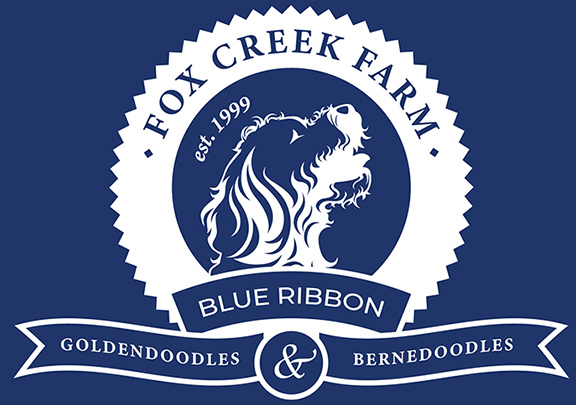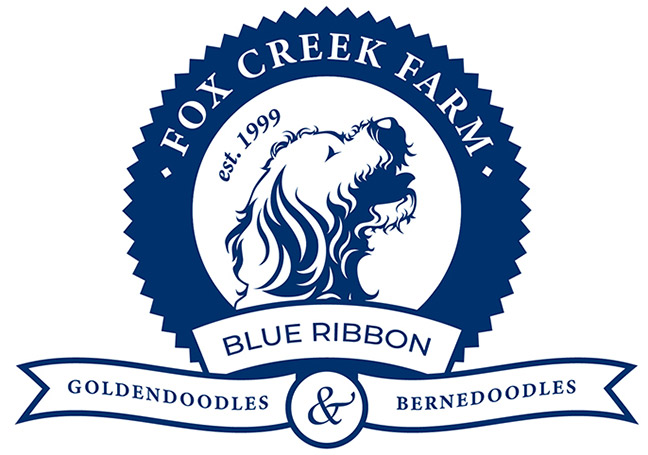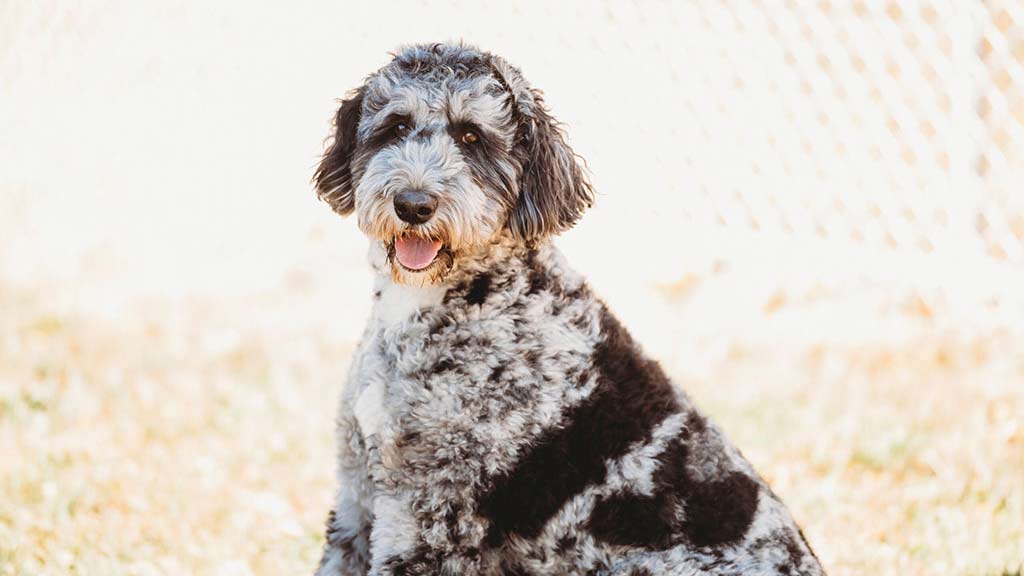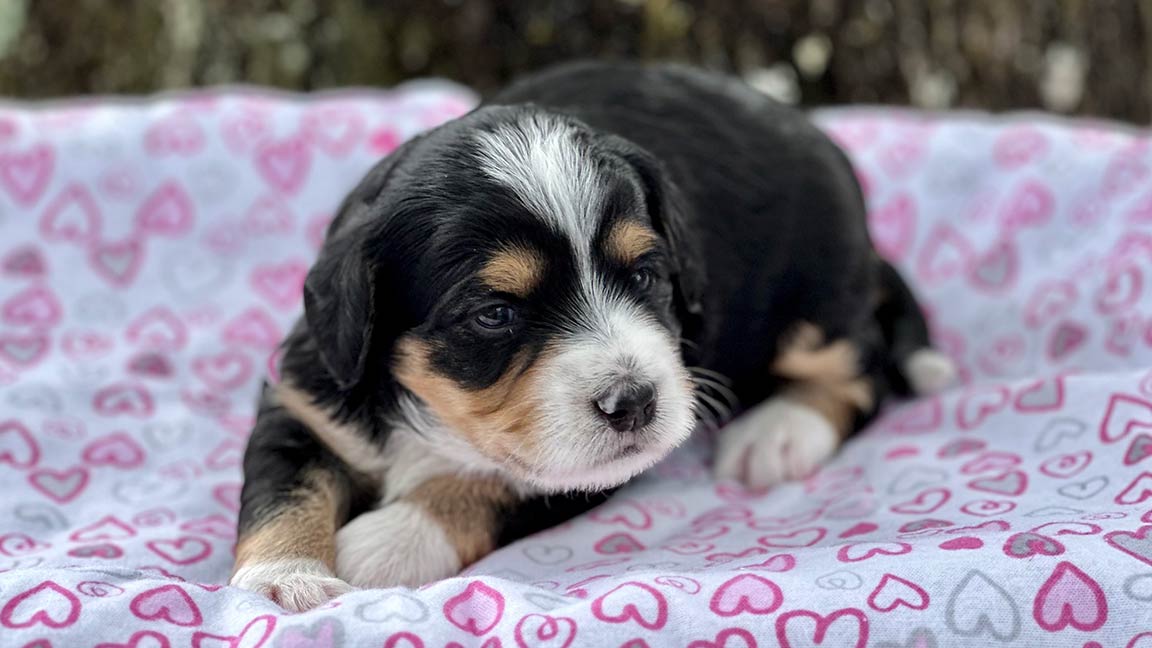
How big do Bernedoodles get?
How big do Bernedoodles get? This is a common question among prospective owners. Understanding the size of Bernedoodles is essential when preparing for their care and space requirements. In this post, we’ll explore how big Bernedoodles get, including their average height, weight, and the factors that influence their growth. Whether you have a standard, mini, or toy Bernedoodle, this guide will help you understand what to expect
A Bernedoodle is a designer breed created by crossing a Bernese Mountain Dog with a Poodle. This combination brings together the best traits of both breeds, including the friendly, loyal nature of the Bernese Mountain Dog and the intelligence and low-shedding coat of the Poodle. Bernedoodles are known for their affectionate personalities, making them a favorite for families, couples, and individuals looking for a loving and playful companion.
What makes Bernedoodles particularly unique is that their size can vary significantly. This is because Poodles come in three different sizes—Standard, Miniature, and Toy—while Bernese Mountain Dogs are large, robust dogs. Depending on the size of the Poodle parent, or in the case of a multigen Bernedoodle, the size of the two Bernedoodle parents, the resulting Bernedoodle can range from quite small to very large.
Key Bernedoodle Traits:
- Friendly & Loyal: They form strong bonds with their families.
- Smart & Trainable: Thanks to their Poodle genes, Bernedoodles are highly intelligent and easy to train.
- Low-Shedding Coats: While not completely hypoallergenic, they shed less than many other breeds.
- Playful & Active: They enjoy physical activity but also know how to relax when needed.
Factors Influencing Bernedoodle Size
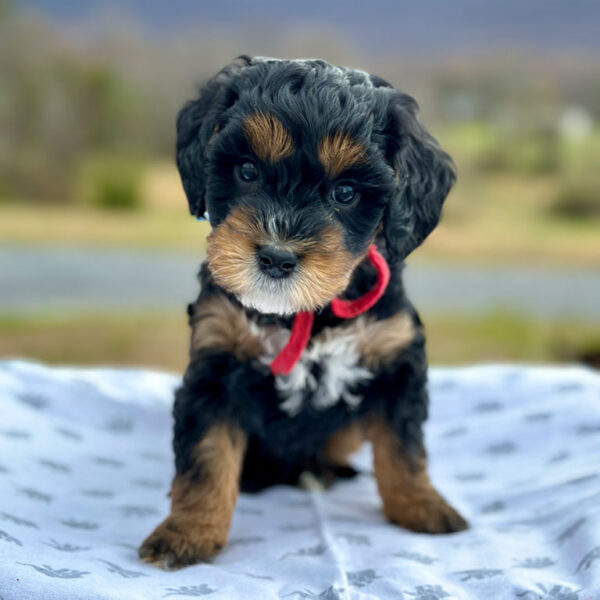
While Bernedoodles come in a variety of sizes, there are several factors that can influence just how big do Bernedoodles get:
- Parent Size: The size of the Poodle or Bernedoodle parent plays a critical role in determining the Bernedoodle’s size. If a Standard Poodle or Bernedoodle is used, the offspring will likely be larger. On the other hand, if a Miniature or Toy Poodle or mini Bernedoodle is used, the resulting Bernedoodle will be smaller.
- Genetics: Just like with humans, genetic variation plays a part. Even within the same litter, Bernedoodles can grow to different sizes depending on which traits they inherit from each parent.
- Gender: Male Bernedoodles are often, though not always, slightly larger than their female counterparts.
- Diet & Exercise: A balanced diet and adequate exercise will affect not only the health of your Bernedoodle but also its size. Overfeeding can lead to an overweight dog, while underfeeding can stunt its growth.
These factors, combined with individual variance, make the size of a Bernedoodle somewhat unpredictable, though a general size range can usually be expected depending on whether the Bernedoodle is classified as Standard, Medium, Miniature, or Petite.
How big do Bernedoodles get: A Size Guide
Understanding the size categories of Bernedoodles can help you make an informed choice about which type is best suited for your lifestyle. Here’s a detailed look at how big do Bernedoodles get:
Standard Bernedoodle
A Standard Bernedoodle is the largest of the Bernedoodle types. When a Standard Poodle or Bernedoodle is used in breeding, these dogs typically grow quite large, often inheriting the sturdy frame of the Bernese Mountain Dog.
- Height: 22-29 inches at the shoulder.
- Weight: 70-90 pounds (sometimes more for males).
Traits:
- Standard Bernedoodles are well-suited to active families or individuals who have plenty of space for a larger dog. They are strong, energetic, and need regular exercise to keep them happy and healthy.
- They’re great with children due to their size and calm temperament, but smaller children should be supervised, as a large dog could accidentally knock them over.
Mini and Medium Bernedoodle
Mini and Medium Bernedoodles are a middle-ground option, bred by crossing a Miniature Poodle with a Bernese Mountain Dog or two Bernedoodles in this size range. These dogs are smaller and tend to have the same affectionate, friendly nature as their larger counterparts.
- Height: 14-21 inches at the shoulder.
- Weight: 26-50 pounds.
Traits:
- Mini and Medium Bernedoodles are a great option for those who want a moderately sized dog that’s easy to manage in smaller homes or urban environments. They still need daily exercise but are not as demanding in terms of space as Standard Bernedoodles.
- They maintain the same loving, social personality of the breed, making them excellent companions for both families and individuals.
Toy/Petite Bernedoodle
Toy or Petite Bernedoodles are the smallest of the Bernedoodle varieties. These little dogs are typically the result of breeding a Toy Poodle with a Mini Bernedoodle or two Toy Bernedoodles, many times taking more than one generation to solidify the smaller size.
- Height: 12-14 inches at the shoulder.
- Weight: 10-24 pounds.
Traits:
- Petite Bernedoodles are ideal for those living in apartments or small homes. Despite their smaller stature, they pack a big personality and are still loving, loyal dogs that enjoy time with their families.
- These dogs are low-shedding and perfect for families looking for a hypoallergenic companion in a smaller package.
Bernedoodle Growth Stages
From puppyhood to adulthood, Bernedoodles undergo several stages of growth. When considering how big do Bernedoodles get, it’s important to understand these stages, as it will help you prepare for their changing needs as they grow.

Puppy Stage (0-6 months): During the first six months of life, Bernedoodles grow rapidly. They begin as small, fluffy pups, and you’ll notice a dramatic change in their size over this period. A Standard Bernedoodle can grow to half of its adult size by six months, while Mini and Toy Bernedoodles will be smaller but also grow quickly during this stage.
Adolescent Stage (6-18 months): By six months, most Bernedoodles will be halfway or more to their full size. They’re still full of energy and might be a bit clumsy as they navigate their growing bodies. It’s crucial to continue with training and socialization during this period to ensure they develop into well-behaved adults.
Adult Stage (18-24 months): Bernedoodles typically reach their full adult size between 18 and 24 months. However, their personality and behaviors might continue to develop even after reaching physical maturity. Males may continue filling out muscle-wise up to three years old, but by this stage, most of their height and weight will be fully established. Petite and Mini Bernedoodles mature quicker than the standard version and mature physically by 18 months of age.
Gender Differences: In general, males grow to be slightly larger than females. While both genders are loving, friendly, and loyal, males might appear bulkier due to their muscle mass.
Living with a Bernedoodle Based on Size
The size of your Bernedoodle will have a direct impact on your living arrangements, activity levels, and daily routines. Let’s explore how different sizes of Bernedoodles fit into various lifestyles and living situations.
Standard Bernedoodles, being the largest of the group, are ideal for families or individuals who have plenty of space and lead active lifestyles. These dogs, often reaching up to 90 pounds or more, need room to move, both indoors and outdoors. If you have a yard or access to open spaces where they can run and play, a Standard Bernedoodle can thrive. They are highly energetic and require regular exercise to keep them physically fit and mentally stimulated.
Standard Bernedoodles also tend to enjoy outdoor activities like hiking, swimming, and jogging, making them a great fit for active families. However, they also enjoy their downtime and will happily relax with you once their exercise needs are met. These gentle giants tend to have a calm demeanor, making them excellent companions for families with children, though supervision is important with very young kids due to the dog’s large size.
On the other hand, Mini and Medium Bernedoodles are a fantastic option for those who want a slightly smaller dog that’s easier to manage in tighter spaces, such as townhouses or smaller homes. These dogs are typically 26 to 50 pounds, making them easier to handle and less demanding in terms of space. Despite their smaller stature, Mini Bernedoodles have all the loving and social characteristics of their larger counterparts.
They still require daily exercise but do not need as much space to run as Standard Bernedoodles. A walk around the neighborhood, a game of fetch in the park, or even indoor playtime can keep them happy. Mini Bernedoodles are also very adaptable and can adjust to a variety of living conditions, including apartment life, as long as they receive adequate exercise and attention.
For those with minimal space, such as apartment dwellers or individuals who prefer smaller dogs, Toy/Petite Bernedoodles offer an ideal solution. Weighing in at 10 to 24 pounds, Tiny Bernedoodles are perfect for people living in urban environments where space is limited. Their small size makes them easy to transport and care for, and they are well-suited for people who want a dog with a big personality but minimal physical requirements.
Despite their smaller size, Toy/Petite Bernedoodles still possess the same loyal and affectionate traits that make Bernedoodles so beloved. They can be lively and playful but are also content to cuddle up with their family, making them excellent companions for those who want a loving pet without the challenges of a larger dog.
No matter the size of the Bernedoodle, one thing is consistent: their ability to bond with their family. Bernedoodles, regardless of size, are affectionate, friendly, and adaptable, making them excellent companions for a wide range of households.
Maintaining Healthy Weight and Size
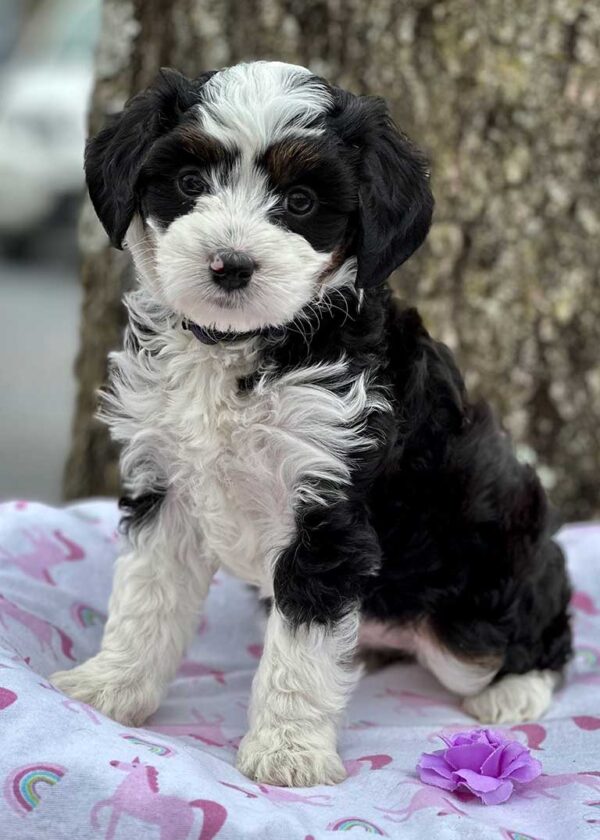 Maintaining a Bernedoodle’s healthy weight is essential to ensuring a long and active life. This requires attention to both diet and exercise, tailored to the dog’s size. Standard Bernedoodles, being larger dogs, have higher caloric needs than their Mini or Petite counterparts. It is important to feed them a balanced diet that includes high-quality protein, fats, and fiber. Typically, a Standard Bernedoodle will need between three to five cups of high-quality dog food daily, split into two meals. As with all dogs, the exact amount will depend on the dog’s age, activity level, metabolism, and quality of the kibble so regular monitoring and consultation with a veterinarian are key.
Maintaining a Bernedoodle’s healthy weight is essential to ensuring a long and active life. This requires attention to both diet and exercise, tailored to the dog’s size. Standard Bernedoodles, being larger dogs, have higher caloric needs than their Mini or Petite counterparts. It is important to feed them a balanced diet that includes high-quality protein, fats, and fiber. Typically, a Standard Bernedoodle will need between three to five cups of high-quality dog food daily, split into two meals. As with all dogs, the exact amount will depend on the dog’s age, activity level, metabolism, and quality of the kibble so regular monitoring and consultation with a veterinarian are key.
Mini and Petite Bernedoodles will require less food, but they still need a nutritionally balanced diet. Mini Bernedoodles generally require between two to three cups of food a day, while Petite Bernedoodles need only about one to two cups. It’s important to avoid overfeeding any size Bernedoodle, as these dogs can be prone to weight gain if their caloric intake exceeds their energy expenditure. Regular exercise, such as daily walks, playtime, and mental stimulation, is crucial to keeping them fit and healthy.
Exercise needs vary depending on the Bernedoodle’s size. Standard Bernedoodles need at least an hour of vigorous exercise per day, whether it’s running, hiking, or playing fetch. Mini Bernedoodles, while still active, can often get by with 30 to 45 minutes of daily exercise, while Petite Bernedoodles can remain healthy and content with shorter bursts of playtime and walks. It’s also important to keep your Bernedoodle mentally engaged, regardless of size. Activities such as puzzle toys, obedience training, and socialization with other dogs can provide the mental stimulation they need to stay sharp.
Finally, keeping an eye on your Bernedoodle’s weight through regular vet checkups will ensure they are in the best possible health. Your vet can recommend an appropriate feeding and exercise plan, helping you maintain your Bernedoodle’s optimal weight throughout their life.
Why Fox Creek Farm Is Your Best Choice for a Bernedoodle
If you’re considering adding a Bernedoodle to your family, there’s no better place to look than Fox Creek Farm Goldendoodles and Bernedoodles. As a breeder with a reputation for producing top-quality Goldendoodles and Bernedoodles, Fox Creek Farm stands out for its ethical practices, focus on health, and dedication to producing well-rounded puppies. The team at Fox Creek Farm places great emphasis on the well-being of the dogs in our care, ensuring that every puppy is raised in a loving environment, which translates to better socialized and healthier pets.
Fox Creek Farm is committed to responsible breeding, ensuring that the parent dogs are healthy, well-cared-for, and undergo genetic testing to reduce the risk of hereditary conditions. This attention to detail means that families can have peace of mind knowing that their new Bernedoodle or Goldendoodle is coming from a reputable and trustworthy source. Whether you’re looking for a Standard, Medium,Mini, or Petite Bernedoodle, Fox Creek Farm offers a range of sizes to meet your needs.
In addition to our careful breeding practices, Fox Creek Farm is known for providing excellent support to new puppy owners. From the moment you bring your puppy home, the Fox Creek team is available to provide guidance on everything from training tips to health care recommendations, ensuring that both you and your new Bernedoodle have a smooth transition.

Conclusion
Understanding how big do Bernedoodles get is crucial to ensuring they fit into your household and lifestyle. From the large and lovable Standard Bernedoodle to the compact but spirited Petite Bernedoodle, there’s a Bernedoodle for every type of home. Whether you’re in need of an active companion for outdoor adventures or a cuddly friend for cozy days inside, knowing the size and needs of your Bernedoodle will help you make the best decision.
No matter how big do Bernedoodles get, one thing is for sure: a Bernedoodle will bring joy, loyalty, and love into your life. And if you’re looking for a top-quality Bernedoodle or Goldendoodle, Fox Creek Farm is the best place to start your journey. With our commitment to ethical breeding and producing healthy, happy puppies, Fox Creek Farm continues to be a trusted name in the world of Bernedoodle and Goldendoodle breeding.
